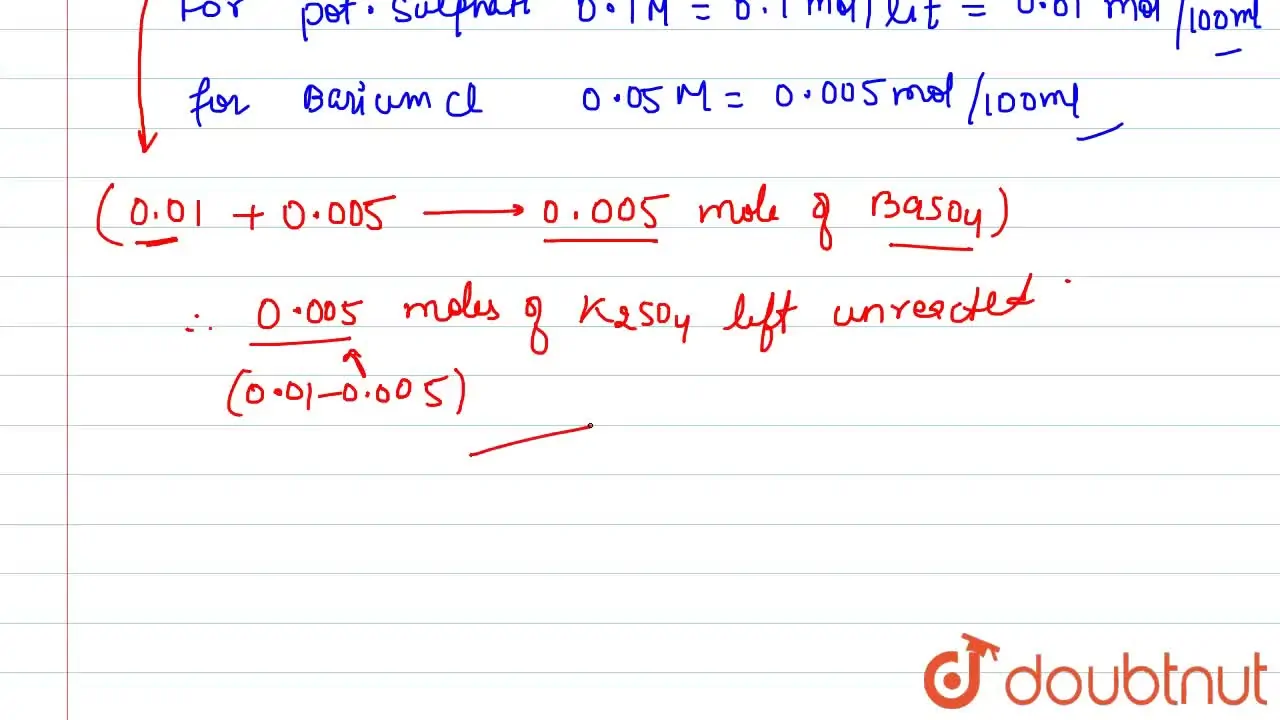Upon mixming 100.0mL to 0.1M potassium solphate solution and 100.0mL of 0.05M barium chloride solution, precipitation of barium sulphate takes place. How many moles of barium sulphate are formed? Also, calculate the molar concentration of species left behind in the solution. Which is the limiting reagent?
K2SO4+BaCl2→BaSO4↓+2KCl
(A.→equation),1mmol, 1mmol, 1mmol, 2mmol),
equation), mmole before, 10×01,100×0.05, -, -
(reaction, = 10 mmol, = mmol),
mmole left after, 10 - 5, -, 5 mmol, 10 mmol),
reaction), = 5 mmol
5 mmol of BaCl2 will react will 5 mmol of K2SO4. HenceBaCl2 is the limiting reagent which is completely consumed in the reaction and it will decied the number of millimiles of products formed.
Total volume of solution =100+100=200mL
Moles of BaSO4 precipitated =5mmol1000mL=0.005mol
Unreacted K2SO4 and KCl are left in the solution.
Concentration of K2SO4 and KCl are left in the solution =5mmol200mL
=0.025M
Concentration of KCl formed in the reaction =10mmol200mL
=0.05M
Related Playlists
- BOOK - CENGAGE CHEMISTRY ENGLISHCHAPTER - SOME BASIC CONCEPTS AND MOLE CONCEPTEXERCISE - Ex 1.1 Objective Questions6videos
SOME BASIC CONCEPTS AND MOLE CONCEPT
- BOOK - CENGAGE CHEMISTRY ENGLISHCHAPTER - SOME BASIC CONCEPTS AND MOLE CONCEPTEXERCISE - Ex 1.1 Objective Questions (Single Correct)3videos
SOME BASIC CONCEPTS AND MOLE CONCEPT
- BOOK - CENGAGE CHEMISTRY ENGLISHCHAPTER - S-BLOCK GROUP 2 - ALKALINE EARTH METALSEXERCISE - Ex 5.1 Objective2videos
S-BLOCK GROUP 2 - ALKALINE EARTH METALS
- BOOK - CENGAGE CHEMISTRY ENGLISHCHAPTER - STATES OF MATTEREXERCISE - Exercises (Ture False)25videos
STATES OF MATTER
Similar Questions
Upon mixing 50.0mL of 0.1M lead nitrate solution with 50.0mL of 0.05M chromic sulphate solution, precipitation of lead sulphate takes place. How many moles of lead sulphate are formed? Also, calculate the molar concentration of the species left behind in the final solution. Which is the limiting reagent?
View SolutionOn mixing 45.0mL of 0.25M lead nitrate solution with 25.0mL of 0.10M chromic sulphate solution, precipitation of lead sulphate takes place. How many moles of lead sulphate are formed? Also calculate the molar concentration of the species left behind solution. Assume the lead sulphate is completely insoluble.
View SolutionUpon mixing 50.0mL of 0.1M lead nitrate solution with 50.0mL of 0.05M chromic sulphate solution, precipitation of lead sulphate takes place. How many moles of lead sulphate are formed and what is the molar concertration of chromic suplhate left in the solution?
View SolutionThe total number of ions present in 1 ml of 0.1 M barium nitrate solution is
View Solution500mL of 0.2MNaCl sol. Is added to 100mL of 0.5MAgNO3 solution resulting in the formation white precipitate of AgCl. How many moles and how many grams of AgCl are formed? Which is the limiting reagent?
View SolutionThe total number of ions present in 1 ml of 0.1M barium nitrate solution is :-
View SolutionWhat is the osmotic pressure of a solution made by mixing 100 mL of 0.1 M acetone and 100 mL of 0.2M fructose solution at
30∘C?View Solution0.98 g of the metal sulphate was dissolved in water and excess of barium chloride was added. The precipitated barium sulphate weighted 0.95 g. Calculate the equivalent weight of the metal.
View SolutionIf 100mL of 0.1M urea solution is mixed with 100mL of 0.2M glucose solution at 300K. Calculate osmotic pressure?
View SolutionHow many moles of sodium chloride present in 250 mL of a 0.50 M NaCl solution ?
View Solution


